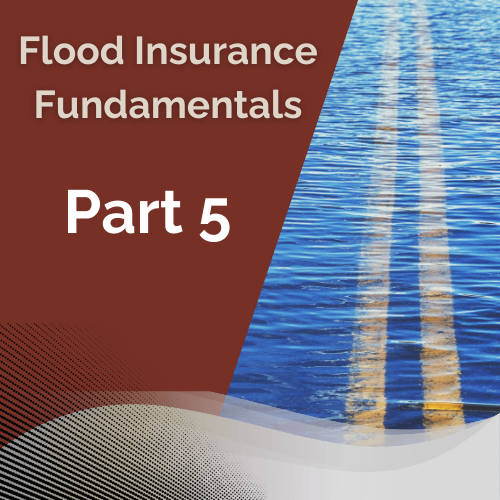Flood Insurance Fundamentals: Part 5

Diving Back In!
In Flood Insurance Fundamentals: Part 5 we pick up where we left off in Part 4
In Part 4 we added to our understanding of the Cost to Rebuild as one of the six primary components of FEMA’s Risk Rating 2.0
We also introduced the seven rating variables FEMA uses to refine individual property risks and applied those variables to our case study of the young couple in Miles City, Mt who we were introduced to in Part 3
Case Study Review

Taking Another Look
- The home is a Single-Family Home with a detached garage
- The home is a Two-story home with a basement
- The home was Built in 1975 in Miles City, MT
- The home is a Pre-FIRM construction
- The home is located in Flood Zone – AE
- The home has a 2-ft First Floor Height
- The type of flooding is Inland flooding
- The home has sustained two flood events in the past (1078 & 2011)
- The couple needs a $250,000 policy for the Building
- The couple needs a $100,000 policy for their personal property
- The couple wants the minimum deductibles for each policy
With our memory refreshed, let’s discuss the 5th component of FEMA’s Risk Rating 2.0 to get a better understanding of what FEMA means by a broader range of flood frequencies
Broader Range of Flood Frequencies

A Full-Spectrum View
FEMA’s Risk Rating 2.0 considers a broader range of flood frequencies as one of the main components in the NFIP pricing approach
This system takes into account multiple flood risk factors beyond what is shown on Flood Insurance Rate Maps (FIRMs)
The approach allows for a more nuanced understanding of flood risk beyond the traditional flood zone designations, resulting in insurance rates that better reflect each property’s specific risk profile
Why Expanded Considerations Were Necessary
The old methodology used by FEMA was outdated and had not been updated in 50 years
It primarily relied on static zones on flood maps and did not account for the full range of variables determining an individual property’s flood risk
- This led to several issues:
- Inequitable pricing: Some policyholders were paying more than their fair share in flood insurance premiums
- Misleading risk communication: The cost of insurance was often misleading, creating a false sense of security for current policyholders and prospective customers
- Inability to adapt to changing risks: The old system couldn’t effectively account for increasing flood risks due to any change in the climate
Impact on Premiums
The primary effect of the expanded considerations is to provide a more accurate and individualized risk assessment
- They serve to:
- Refine risk assessment: By incorporating more data points and risk factors, FEMA can now create a more detailed and accurate risk profile for each property
- Individualize premiums: Rather than relying solely on flood zone designations, premiums now reflect the unique risk characteristics of each property
- Adjust pricing accuracy: Some properties may see premium increases due to newly recognized risks, while others may experience decreases as the expanded considerations reveal lower risk than previously assumed
- Reflect real-world conditions: By considering factors like urban flooding and pluvial flooding, premiums now better align with the actual flood risks properties face
- Account for changing risks: The new system is better equipped to adapt to evolving flood risks due to factors like a change in climate and urban development
This nuanced approach to risk assessment allows for premiums that more closely match each property’s actual flood risk, rather than broad categorizations based primarily on flood zones
Now let’s pivot to the final primary component of FEMA’s Risk Rating 2.0 which addresses the CRS Discount, Fees, and Surcharges
CRS Discount, Fees, and Surcharges

Charges with a Side of Savings
In this section, we will focus on the Community Rating System (CRS) Discount, the Reserve Fund Assessment, the HFIAA Premium Surcharge, and the Federal Policy Fee
These elements finalize the premium a policyholder pays under Risk Rating 2.0
Community Rating System (CRS) Discount
The purpose of the CRS Discount is to encourage communities to exceed the minimum NFIP requirements
The discount is applied uniformly in qualifying communities and it represents a flat percentage based on CRS classification regardless of flood zone
Community ratings for your community can be found HERE
- Discounts range from 5% to 45%, increasing in 5% increments based on the community’s CRS classification
- The discount is applied to the full-risk premium for all policies in the Regular Program within a participating community
- Miles City, MT is Class 7 earning a 15% discount
Note: Buildings not in compliance with community floodplain regulations or that have known floodplain management violations are ineligible for the CRS premium discount
Reserve Fund Assessment

Essentially, A Piggy Bank for the Piggy Bank
The Reserve Fund for the National Flood Insurance Program (NFIP) was created by the Biggert-Waters Flood Insurance Reform Act of 2012
The Reserve Fund is a separate account established by FEMA for the National Flood Insurance Program (NFIP) to meet expected future obligations including claim payments and debt repayment
FEMA began charging a Reserve Fund assessment on every NFIP policy since April 2016
The Reserve Fund is financed through an assessment added to NFIP premiums that currently stands at 18% of the underlying premium
Why the Reserve Fund was Necessary
The Reserve Fund and its associated Assessment was created to address several financial challenges facing the National Flood Insurance Program (NFIP):
Financial Stability
The NFIP had been accumulating significant debt, particularly since Hurricane Katrina in 2005.
The Reserve Fund was created to build financial resilience and help meet future obligations
Meeting Claim Obligations
The assessment seeks to establish and maintain a reserve fund to cover future claims, especially for catastrophic loss years
Reducing Reliance on Borrowing
By building up a reserve, the NFIP can reduce its need to borrow from the U.S. Treasury to pay claims after major flooding events
Managing Increasing Flood Risks
Weather patterns had increased flood risk beyond what was anticipated when the NFIP was created over 50 years ago, necessitating additional financial resources
Balancing Affordability and Fiscal Soundness
The Reserve Fund was part of broader efforts to create a more financially stable NFIP while still maintaining affordability for policyholders
Who is Exempt From the Reserve Fund Assessment
Most NFIP policyholders will pay the Reserve Fund Assessment with one notable exception
The exception is The Group Flood Insurance Policy (GFIP)
The Group Flood Insurance Policy (GFIP) is a special type of flood insurance coverage offered by FEMA to individuals who have received federal disaster assistance after a presidentially declared disaster that included flooding
FEMA pays the premium directly to the NFIP from the recipient’s Individuals and Households Program (IHP) disaster assistance grant
GFIP policies are exempt from the Reserve Fund Assessment because these policies are provided to eligible recipients of federal disaster assistance and are funded directly by FEMA
What is the HFIAA Surcharge?

It’s Another Name for a Tax
The Homeowner Flood Insurance Affordability Act (HFIAA) of 2014 introduced a surcharge on all National Flood Insurance Program (NFIP) policies
The surcharge was implemented to help fund the costs associated with the HFIAA and to address the financial challenges facing the NFIP
The Context
The National Flood Insurance Program (NFIP) was facing significant financial challenges both before and after the passage of the Biggert-Waters Flood Insurance Reform Act of 2012 (BW-12)
The HFIAA Surcharge was created by the Homeowner Flood Insurance Affordability Act of 2014 (HFIAA) as a budgetary stop-gap for the foregone revenues from changes passed in HFIAA
- Before BW-12, the NFIP was already in substantial debt, largely due to catastrophic events like Hurricane Katrina in August 2005
- At the time BW-12 was passed, the NFIP had approximately $24 billion in debt
- The program was structurally unsound due to subsidized premiums that did not accurately reflect flood risks
- BW-12 aimed to address these financial challenges by phasing out subsidies and bringing premium rates closer to actuarial risk
- However, 18 months after BW-12’s passage, the NFIP remained in financial distress, partly due to additional losses from Superstorm Sandy
- The NFIP’s financial situation has been so concerning that the Government Accountability Office (GAO) had placed it on its High-Risk List since 2006 to Current (February 2025)
Forgone Revenues From Changes Passed in HFIAA Refers To
- The HFIAA rolled back some of the rate increases that were implemented by the Biggert-Waters Flood Insurance Reform Act of 2012 (BW-12)
- BW-12 had originally aimed to make the NFIP more financially solvent by removing certain premium discounts and subsidies
- When HFIAA slowed down or reversed some of these rate increases, it resulted in less revenue for the NFIP than what would have been collected under BW-12
- To compensate for this lost potential revenue, HFIAA introduced the HFIAA Surcharge as a “budgetary stop-gap”
- Effectively, what FEMA gives up in the short-run will be gained in the long-run
Why the Rollbacks in HFIAA Were Necessary
The Homeowner Flood Insurance Affordability Act of 2014 (HFIAA) rolled back some of the rate increases implemented by the Biggert-Waters Flood Insurance Reform Act of 2012 (BW-12) for several reasons:
Affordability Concerns
Many policyholders expressed that the new premiums resulting from BW-12 were unaffordable
The increased rates were causing financial hardship for some homeowners and potentially affecting property values in flood-prone areas
Rapid Implementation
BW-12 required a quick transition to actuarially sound pricing, which led to sudden and substantial premium increases for some policyholders
Economic Impact
There were concerns that the higher premiums would adversely affect home values in certain areas, potentially causing economic distress
Political Pressure
The significant rate increases prompted a backlash from affected homeowners, leading to political pressure to address the issue
Balancing Financial Stability with Affordability
While BW-12 aimed to address the NFIP’s growing deficit, HFIAA sought to strike a balance between improving the program’s financial stability and maintaining affordable flood insurance for homeowners
Allowing Time for Reassessment
HFIAA provided a four-year delay for premium increases, during which FEMA was tasked with reassessing its flood maps and developing a plan to make premiums more affordable
The Cumulative Effect
By rolling back some of the BW-12 rate increases, HFIAA aimed to address affordability concerns while still working towards improving the long-term financial sustainability of the National Flood Insurance Program
However, recent catastrophic events like Hurricane Helene in 2024, which caused an estimated $59.6 billion in damages in North Carolina alone, highlight the ongoing challenges facing the NFIP.
Furthermore, FEMA’s commitment to provide a paltry $750 to meet the immediate needs of the 4.6 million residents in the 39 counties in North Carolina designated for federal disaster assistance accentuates the financial struggles facing FEMA
Note: Despite efforts to balance affordability and sustainability, FEMA’s financial pressures extend beyond natural disasters
FEMA maintains many other obligations, like an 80.9 million dollar commitment to New York City for reimbursements covering the period from November 2023 to October 2024
This funding was to provide housing and other services to approximately 46,000 illegal aliens in hotels in New York City at an average cost of $156 per room per night until it was “clawed back” by the current administration
Back to the HFIAA Surcharge
The HFIAA surcharge applies to all new and renewed policies annually.
It is a flat fee applied to primary residences or all other policies
The fee amounts are:
$25 for Primary Residences
Defined as a single-Family Home, Residential Manufactured/Mobile Home, residential Unit, or Two-to-Four Family Building in which the policyholder or the policyholder’s spouse lives
$250 for All Other Policies
- Defined as Non-Primary residences and the following Building occupancies:
- Other Residential Building
- Residential Condominium Building
- Non-Residential Building
- Non-residential Manufactured/Mobile building
- Non-Residential Unit
Note: A non-primary residence is a residential building that is not the primary residence of the policyholder
The Federal Policy Fee

The Original Tax
The Federal Policy Fee was created as part of the National Flood Insurance Program (NFIP), which was established by the National Flood Insurance Act of 1968
The Federal Policy Fee is a flat charge paid by the policyholder on each new and renewed policy to defray certain administrative expenses incurred in carrying out the NFIP and was designed to make the program self-sustaining
The Federal Policy Fee Varies Based on the Building Occupancy and Unit Structure
Building Occupancy: $47 Fee
- Single-Family Home
- Residential Manufactured/Mobile Home
- Residential Unit
- Two-To-Four Family Building
- Other Residential Building
- Non-Residential Building
- Non-Residential Manufactured/Mobile Building
- Non-Residential Unit
Unit Structure
- Residential Condominium Building
- Units 1 – 20: $47 per unit
- Units 21 – 40: $20 per unit
- Units 41 – 100: $10 per unit
- Units 101+: $2 per unit
- Example: Residential Condominium Building with 60 units
- Units 1 – 20 = $940
- Units 21 – 40 = $400
- Units 41 – 60 = $200
- Total Fee = $1,540
And that sums it up for the Discounts, Fees, and Surcharges. Next are a few items you may want to remember as we highlight the takeaways from Part 5
Takeaways

Tattoo This on My Brain
- Community Rating System (CRS) Discounts provide an incentive for communities to keep flood insurance costs down for its citizens
- The Reserve Fund Assessment builds reserves to fund future claims activities
- The Homeowner Flood Insurance Affordability Act surcharge applies to all new and renewal policies
Remember in Part 3, we began discussing the 4 steps required to determine NFIP flood insurance rates.
Well, brace yourself, thrill-seeker, because we’re about to dive into the third step in Part 6!



Leave a Reply